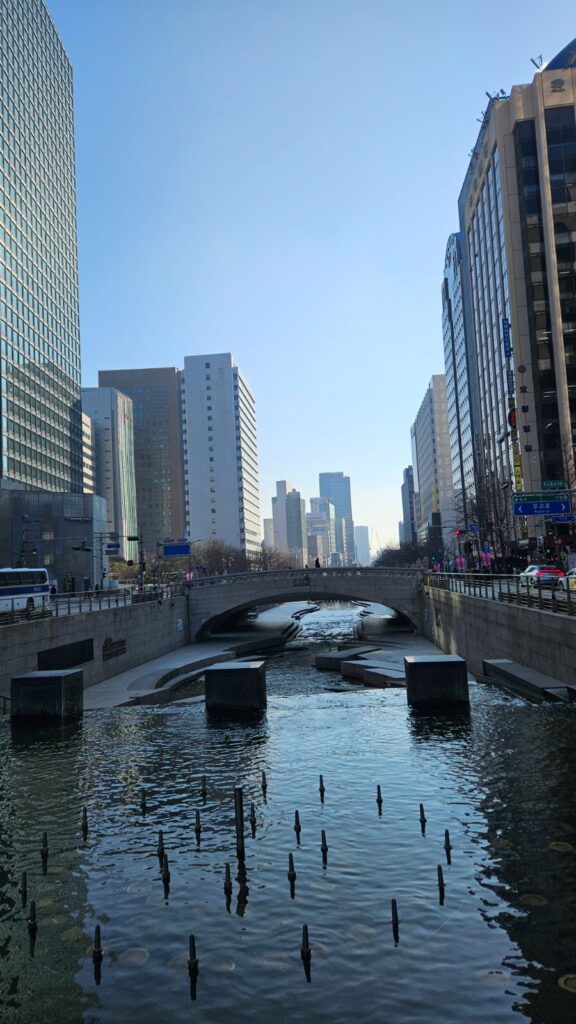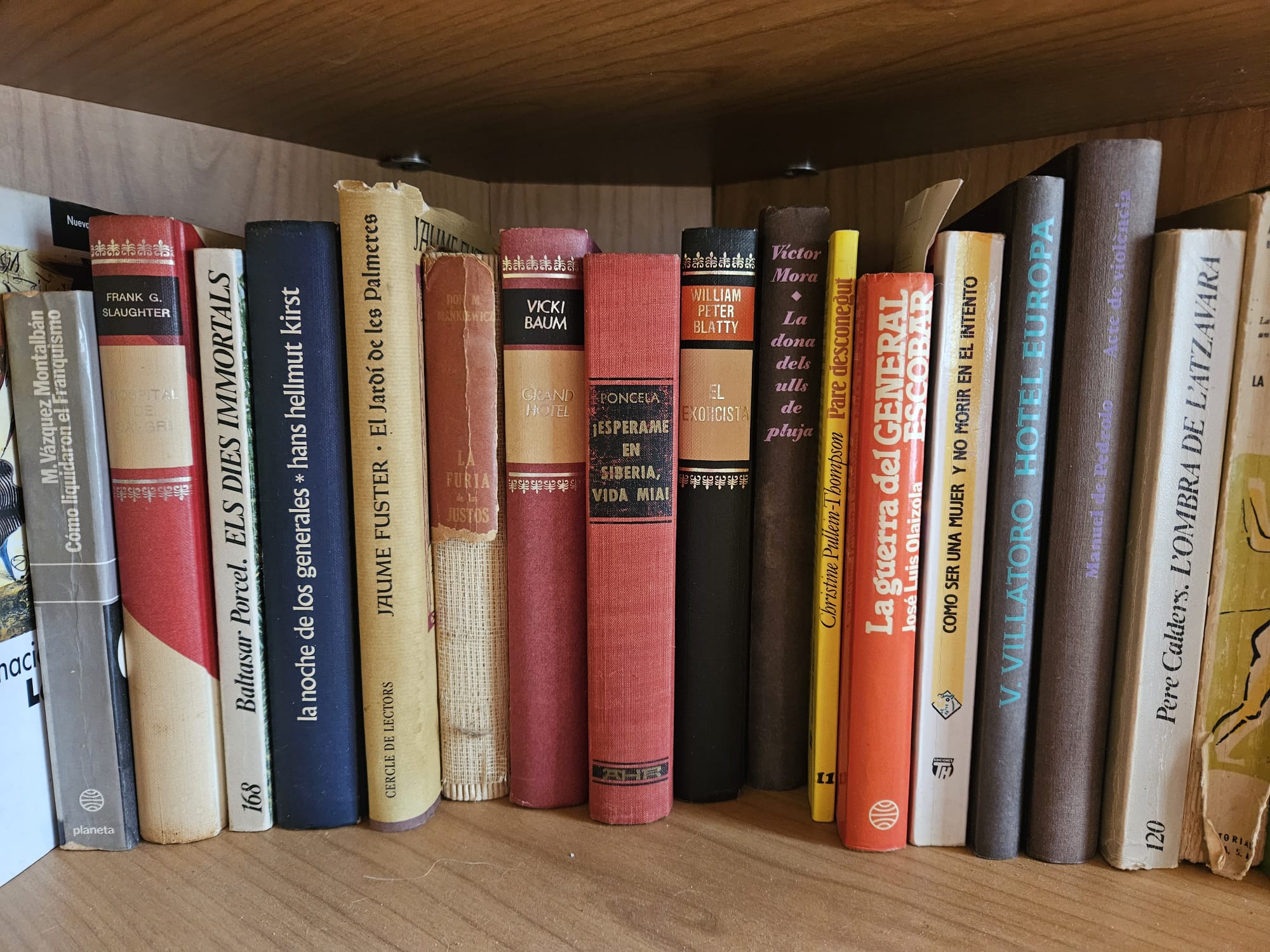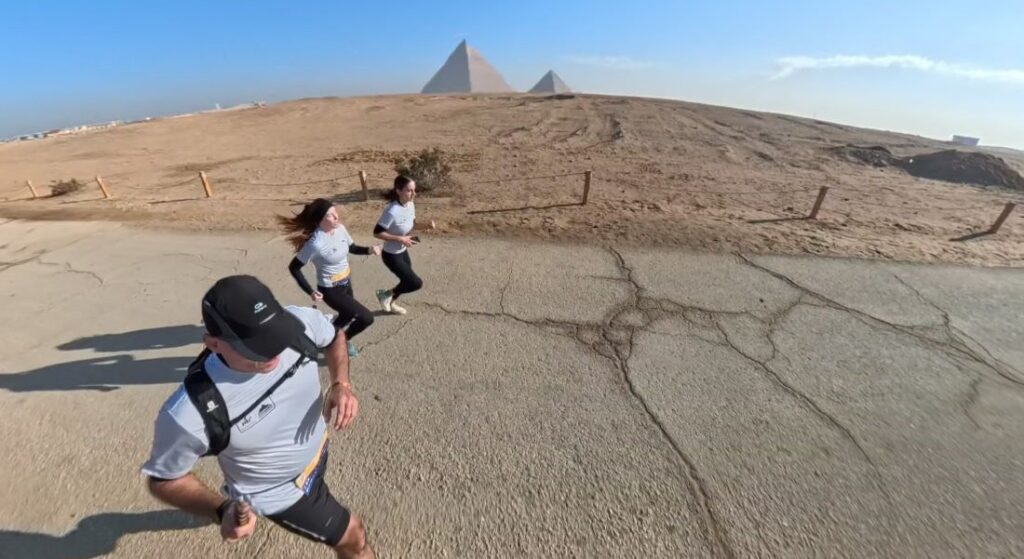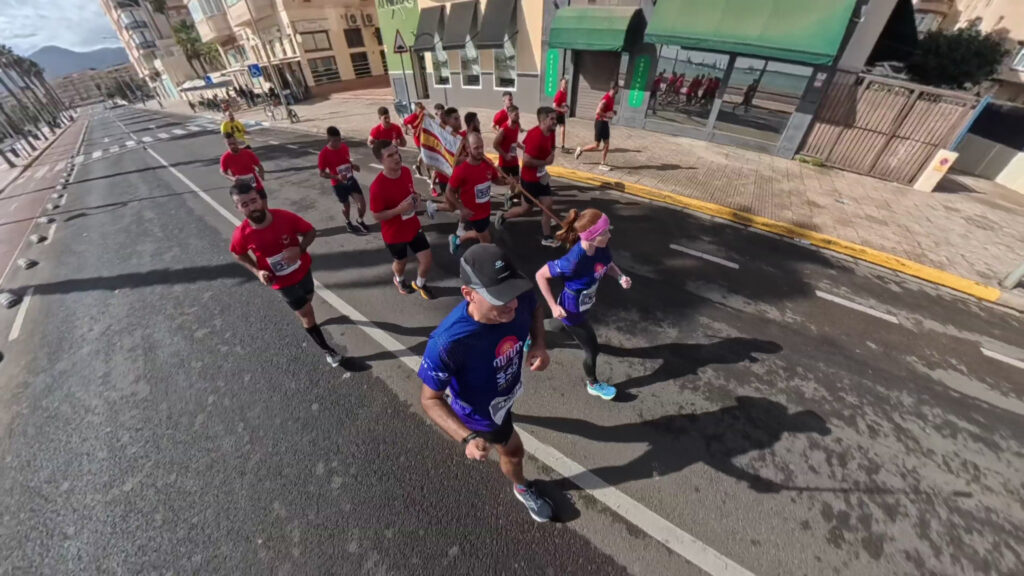Gyeonggi International Half Marathon. Suwon, South Korea. 25th February 2024.
On a cold February morning and with sleet falling from grey skies, we took part in the “Gyeonggi International Half Marathon”. We ran streets flanked with sky scrappers and tiny shops, in a race that proved very popular with locals of Suwon, the home of the magnificent Hwaseong Fortress.
TLDR; “too long, didn’t read”
- I just want to run! Take me to RACE.
- I have 1 minute. Take me to USEFUL INFORMATION.
- Running is my excuse for travelling. Take me to TRIP.
- Running is my excuse for eating. Take me to CARBOLOADING.
- While in Korea, I want to visit the most famous DMZ in the world. Take me to TRIP SPECIAL BONUS.
- I want to know what to read or watch in the plane. Take me to ONE BOOK / TO KNOW MORE.
🌍 The trip 📷: Getting to South Korea
On our way to run the Tokyo marathon, we decided to spend a few days in Korea, and, since we were going to visit the country, why don’t find an official race to run?
That’s exactly what we did: the Gyeonggi Suwon Half Marathon 💪!
We arrived at Seoul’s International airport after a 12 hour flight from Barcelona ✈️. Thanks to Gaudi and the new fame of Barcelona as a “must visit” city, now we can fly directly from our city to South Korea 🤟.
In Incheon the atmosphere was dense and the sky gray, and we saw patches of snow on the roofs of the airport buildings. It was a 24th of February and the “Gyeonggi International Half Marathon” organization had been right when warning us that “it is going to be cold” (see email screenshot below!)
Tourist Tip 📓: We took one of the “international taxis”, which are driven by English-speaking chauffeurs, and are clearly marked accordingly. Not cheap but very convenient.
We drove along the longest Cable-stayed bridge in South Korea, the Incheon bridge, with 3 lanes in each direction, and we saw below the massive Port of Incheon.
On such a winter day, everything looked sad and impersonal. What struck me the most were the hundreds of skyscrapers that had been built or were being built in the Songdo area: all of them looked as gray and as sad as the rest of the landscape.
🏃♀️ The race 🏃♂️
Building up 💪
As I mentioned before, we were lucky on our “around the world in 80 runs” because the weekend before the Tokyo Marathon, there was a race with 21k, 10k and 5k distances organised in the south of Seoul. In the city of Suwon, the capital of the Gyeonggi province.
The process of signing up, though, was not straightforward.
Firstly, the web was written in Korean and, although I could use google translate, most of the content was in form of images: so I had to use the application in my cell phone.

Once I managed to sign in, the process of paying was also dififcult and I used the online service Wise. The anecdote is that I transferred a little bit more, not to mess up with the currency exchange, and I got the following reply from the organisation.

So nice!
Here‘s the official video for the Suwon Half Marathon. Like in the web, everything is in Korean and I could only understand “Run for fun” and the fact that there were 3 distances:
- Half marathon
- 10k
- 5k
Getting there
The race was scheduled to start at 8am, half an hour before than initially thought. This was because the number of participants was higher than expected, and the organization wanted to keep the traffic disruption at a minimum.

We had picked the hotel Dono1796, in the heart of Suwon right next to Hwaseong Fortress, and which was 1 kilometer away from the Suwon FC Sports Complex, where the start and the finish were located.
So we walked there, hurrying along empty avenues and streets. This was our first taste of South Korea’s urban landscapes, with skyscrapers, shops with marketing full of colors and drawings, and alleys with old buildings with their characteristic curved roof covered with tiles.

It was very cold but we were well equipped, with our ‘winter equipment’ that I have listed in this post.
The starting line in the Suwon FC stadium

We arrived to the stadium around 7am, at the same time that other hundreds of people flowing to the start line. And we could pickup our ‘courier’ packet which included:
- The bibs, protected by plastic. We actually ran with our bibs inside the plastic!
- The official t shirts. They were of a beautiful sky-blue; we had picked larger sizes than usual because here people are normally smaller than us Westerners. In fact Roger’s was 3XL (he normally wears a XL) and it was tight on him!
A very nice lady from “Operations” helped us to the storage area, where we could leave our goods. We had the queue in the rain but other than this, and the puddles in the tartan which soaked our trainers 💧, all was good and dandy.
Hundreds of Koreans were warming up, running or walking around the tartan, which was also of the same sky-blue color of the shirts. Loads were also queuing for any of the multiple stands around the stadium. We got a super warm and sweet coffee that helped us fight the low temperatures! ☕ It was lovely.
About to start
We were the only Westerners around (we only saw a girl after the race) and some people asked us where we were from.
First the elite runners took off while fireworks exploded very next to us, as seen in the picture:

The rest of us run under the category “Masters”.
Vangelis’ song of the 2002 Korea and Japan World cup sounded, and I became emotional. That world cup was the first one that Roger and I went to together, 22 years ago!
Anyway, the music was muffled by some speakers who were talking frantically. We had no idea what they were saying, apart from when they counted down!

The first kilometers
There were no waves or corrals, but we could start at our own pace because the race was not too crowded and people were very civilized.
You start running out of the stadium and then down a very wide avenue. The next kilometers you run along wide avenues as well, surrounded by tall pollution-dark skyscrapers and closed shops. This, added to the fact that it was gray and rainy, was quite depressing. Plus there were no spectators.
One thing I had never seen was many mothers (and a father) running holding hands with their children 👩👦😍.
The middle of the race
There was an aid station at kilometer 2.5; we ran past it at the same time that the first runners of the 5k race passed by us… running very, very fast. It was surprising to see how young they all were!
You turn at kilometer 5k, where another aid station is, and run the same route.
Still no spectators and some snow ⛄. Not the most cheerful race to run! There were no people dressed funny, or with fancy dresses. Almost everyone dressed in black or with the blue t-shirts of the race. It was very… army-like!
Final part of the race
Then the kilometers 17 and 18 for the half are marked together with the 5.9 and 6.9 for the 10k. All very exact!
We ran at a constant 5:17 mins/km pace, which allowed us to finish in 52m, because this was actually a ‘training run’ for the Tokyo marathon the following week. We didn’t run faster as we wanted to get our legs too tired. Still, because we had started at the back part, we were constantly overtaking people.
Until… we were massively overtaken by the first runners of the half marathon! 🏃♂️🏃♂️ First we saw a Korean runner, followed by two black runners (the only black runners in the whole race, as far as we could see).
The final km was uphill and it was split between the “elite” (left side) and “masters” (right side).
After a race with such a ‘sad atmosphere’, we finished ‘on a high’ because not only we overtook a lot of runners, but we high-fived ✋ a policeman 👮 who was controlling the race, standing in the middle of the street. This gave us a weird sense of accomplishment!
After the finish
There were a lot of stands giving bottles of water and a finisher pack with chocolate milk, a big pastry with peanut butter inside and a massive cookie.

And, again, we had to queue to receive our 10K medals 🏅, which were quite small but cute.
We came back to the hotel walking, along streets that were slowly waking up, and traffic police who were nervously directing traffic in every corner.

The results were supposed to appear in the marazone.co.kr web the day after and, as I write this lines (Tuesday), I still haven’t managed to see them 🙁..
All in all, I really enjoyed this race because it was a true local experience! (Wow, I sound like a tourist pamphlet 😜)

🌍 The trip 📷: What to see in Suwon in one day
We spent the rest of the Sunday visiting Suwon city center and the impressive Hwaseong Fortress, also known as Suwon Hwaseong. It is a massive fortification surrounding the center of old Suwon. So massive that you can walk above its walls for more than 6 kms!

And we did walk! We enjoyed going up and down the old stone stairs with patches of snow, passing by pavilions, command posts and even secret gates!!. We also went up the Paldasan, the hill:

From there you can enjoy a magnificent view of Suwon:

It was worth it, not only because it was good for our marathon training 😜, but because the views of the city with the snowed mountains at the back was magnificent; albeit wintery. I couldn’t help but think how beautiful this walk must be in spring, with the trees and flowers in full bloom.

Btw, the fortress has a very sad story behind it, with ‘crazy’ king Sado: check this blog which explains it at length.
🌍 The trip 📷: What to see in Seoul in one day
The day after, we travelled to Seoul to visit the massive and vibrant capital city of South Korea.
And Seoul did not dissapoint us. What a great city, full of contrasts; from palaces rich in art to financial city districts bustling with life!
Tourist Tip 📓: Google Maps doesn't work in South Korea. Use Kakao: it's the tool used in South Korea not only for navigating, but also it's the local Uber.
We decided on the following route, that included all of the highlights we wanted to see in one day:
- Deoksugung Palace
- Cheonggyecheon Stream
- Gyeongbokgung Palace
- Hanok Village
- N Seoul Tower
- Namdaemun Market
We did the whole list on foot (except from taking the cable bus to N Seoul tower), and it took us aproximately 6 hours.
Deoksugung Palace
A palace in the middle of the financial district!

Walking around the city centre streets, not only you find gates to palaces or pavillions, like Bosingak, a large bell pavilion in Jongo:

… but you also find a massive sculputre of 💗 Hechi 💗, the mascot for the city of Seoul!

Cheonggyecheon Stream
The Cheonggyecheon Stream is a natural stream in downtown Seoul that proves very popular with the city workers:

Gyeongbokgung Palace
Reserve two hours at least to visit the large, magnificent and extremely richly decorated Gyeongbokgung Palace, the gem of the Joseon dinasty. The palace was built as the official palace of the Joseon dynasty by Yi Seong-gye, who became King Taejo and the founder of the new regime.

And we were lucky enough to see the change of the Guard, which takes place between the Gwanghwamun Gate, the Main and South Gate, and Heungnyemun Gate, the Second Inner Gate:

Tourist Tip 📓: Do not miss the change of the guard ceremony in Gyeongbokgung Palace at 10am! It is free. Please beware that Gyeongbokgung is closed on Tuesdays!

Although destroyed at large during the Japanese occupation, the palace has since then been progresively restored and now the many visitors can enjoy it as its old splendour!

And, by the way, many many locals (and some tourists) were visiting dressed like back during the Joseon times. Apparently it is a very popular thing! And I ended up picking up from the floor a lot of pearl hair pins 😂

Bukchon Hanok Village
It is a pleasure to get lost in the meandering streets of Bukchon Village, a village made up of traditional korean houses, called “Hanok”. This used to be a residential area for the nobility during the Joseon times. Nowadays, although it was very crowded, it was still worth it.
Runners' Tip 📓: It is hilly! Do not do it the day previous to a race!

N Seoul Tower
The N Seoul Tower, also known as Namsan or Seoul Tower, is a communication and observation tower on Nansam mountain which since 1969 has become a landmark of the city.

Namdaemun Market
The largest city market, in Namdaeum not only you can enjoy all kinds of shopping goods and street food,

But also, next to the busy streets, you can find the Namdaemun Gate, which dates from the 14th century:

🌍 The trip, Special Bonus 📷: The DMZ
While in South Korea, we couldn’t miss visiting the Demilitarized Zone (DMZ) because of its historical significance.
The DMZ represents the division between North and South Korea, stemming from the Korean War. It offers insight into the complex history and ongoing tensions between the two countries and it is also one of the few places in the world where you can observe the effects of a longstanding conflict and experience the tension between two nations… still technically at war!

As well as walking amongst the many monuments, peace bells and altars, we saw thousands of “prayer ribbons” or “wish ribbons”, colorful strips of fabric or paper on which visitors write messages of peace, hope, and reunification for the Korean Peninsula.
We could not reach Panmunjom, where negotiations between North and South Korea have historically taken place, during our tour. But our guide shared some pictures she took in the Joint Security Area (JSA), where soldiers from both sides stand face-to-face, like this one:

During the tour we had the opportunity to go down the “Third Tunnel of Aggression”. This tunnel, discovered in 1978, is one of several tunnels dug by North Korea for potential military infiltration into the South:

Runners' Tip 📓: It has 73m of elevation (240 ft)! Which means you will have to go down 73m and up again... So, do not do it the day previous to a race! If, on the contrary, you still have a few days of spare or visit after the race, then it is ideal for training 😜.
One highlight was to actually see North Korea from the famous Dora Observatory, which provides a glimpse into life across the border. We took the following picture of the North Korean flag:


Useful information
🏆 Gyeonggi Suwon Half Marathon in Suwon, in South Korea, in Asia. 21kms, 10kms and 5kms.
🌐 Website: https://www.ggimarathon.com/ggimarathon/
🗓️ Last weekend of February in Suwon, Gyeonggi province in South Korea, Asia.
👟 Urban: Bring shoes for asphalt. And warm gear, like the one recommended here.
✅ Very well organized. You will spend a lot of time queueing but that will make for a more ‘local’ experience. And a friendly atmosphere!
✅ A good course, with no brutal elevations and wide avenues all race long.
❌The logistics of signing up when you are not living in Korea are a nightmare. The website is all in Korean and translation is difficult as there are a lot of images 😁. Plus, to pay for it you need to do a transfer and the European IBAN system does not work…
❌ It is coooold! 🌨️
🍜 Carboloading and Protein Recovery 🍝: What to eat in South Korea if you are a runner
Carboloading 🍜
We started “preparing” by eating in Korean restaurants in our hometown; specially after having watched the importance of food in Korea’s culture in some of the “K-dramas” that I list below, in the section “To know more”.
In fact, here there is an article about “8 dishes that you have seen in Korean Dramas” 🤭
If you happen to be in Barcelona, I highly recommend cozy, family-run restaurant Sinla, of very good quality without being pricy. In there you can enjoy all of the dishes I mention in the post and soups like Korean Spicy Beef Soup (Yukaejang).

For carboloading, I recommend Bibimbap for its high content in carbohydrates, and which in fact in korean means “mixed rice with meat and assorted vegetables“.
Protein for recovery 🥩
A very popular dish is Bulgogi (Korean Beef Barbecue) which is high on protein, because it has thinly sliced beef with a smoky-sweet flavor, accompanied with lettuce wraps and Gochujang (spicy red pepper paste) for wrapping and spicing up the meat:

Here’s the recipe.
The picture above was taken after the Suwon’s 10K race, when we were in search of protein. We ended up in a small restaurant where only locals ate and the dishes were not translated to English. One dish that caught my attention had… cooked silkworm pupae! 🐛🐛🐛
Judging by the price, it was a delicacy. Later, doing some research, I came to learn that Beondegi is a super popular snack! Here’s a recipe …
In Seoul, we also had he the traditional barbacue “cook-at-your-table“; special mention to the Chadolbaegi, Brisket, which was delicious!


Map
Although the Web was not easy to navigate, finally I was able to find the course map(s), for the Half, the 10k and the 5k races:


One book
“Pachinko”, by Min Jin Lee
I have selected the hystorical drama “Pachinko”, written by Korean-American author Min Jin Lee, because I really enjoy historical epic novels, and also because the story is developed both in Korea and in Japan (which was our next stop for the trip).
The story takes place during the Japanese occupation of Korea, and was a finalist of the National Book Awards in 2017.
In case you are curious about the author, here’s a podcasted interview with the author, Min Jin Lee, which I found very interesting.
The book has inspired a TV series, that at the time when I write this post, I haven’t seen yet 📺. It has very high reviews and has the uberfamous Lee Min-ho as one of the main male characters.

Plot: In the early 1900s, teenaged Sunja, the adored daughter of a crippled fisherman, falls for a wealthy stranger at the seashore near her home in Korea. He promises her the world, but when she discovers she is pregnant–and that her lover is married–she refuses to be bought. Instead, she accepts an offer of marriage from a gentle, sickly minister passing through on his way to Japan. But her decision to abandon her home, and to reject her son’s powerful father, sets off a dramatic saga that will echo down through the generations.

To know more…
Over the last years, “K-dramas” have become incresingly popular, but I started watching them almost by chance. And I admit: it is so easy to get hooked!
After having watched a several, I have selected my three favourite ones:
“Hometown Cha Cha Cha”

Plot: “A big-city dentist opens up a practice in a close-knit seaside village, home to a charming jack-of-all-trades who is her polar opposite in every way”
My favourite series 😍 (I have watched them three times already! 😱) takes place in the fictional seaside village of Gongjin.
In fact, the series is so popular that many people visit the real town where most of the series scenes were shot, the city of Pohang; here‘s information, directions and pictures of the familiar locations in the series, like Chief Hon’s house or the iconic Red Lighthouse.
“Crash landing on you”
The premise is already… let’s say, controversial:

Plot: “When famous fashion company owner Yoon Se-ri finds herself trapped in North Korea after a devastating paragliding accident, she meets Ri Jeong-hyeok, a respectable military captain. During her stay, Se-ri discovers the hardships of living in North Korea, and as she slowly falls in love with Captain Ri, it is up to her and her fellow North Korean comrades to find her way back home to the South while hiding their love for each other“
The series is well developed, and I loved the character of Captain Ri 😍, played by famous actor Hyun Bin.
Mr. Sunshine
Do not be fooled by its name, the series has no “rainbows, sunshines and unicorns” 🌈🌞 🦄 … It is a good drama and even a better romance, depicting vividly the turbulent times when the Joseon dinasty ended. Including the Shinmiyangyo incident, a United States ‘expedition’ to Korea, in 1871.

Plot: “Mr. Sunshine centers on a young boy who is born into slavery but after a traumatic event escapes to the United States during the 1871 Shinmiyangyo (U.S. expedition to Korea). He returns to Joseon later as a United States Marine Corps officer. He meets and falls in love with an aristocrat’s daughter. At the same time, he discovers a plot by foreign forces to colonize Korea”
Other dramas I can also recommend are “The King’s affection” and “Run on”, this last one because the main character is a runner, a track star 😋




